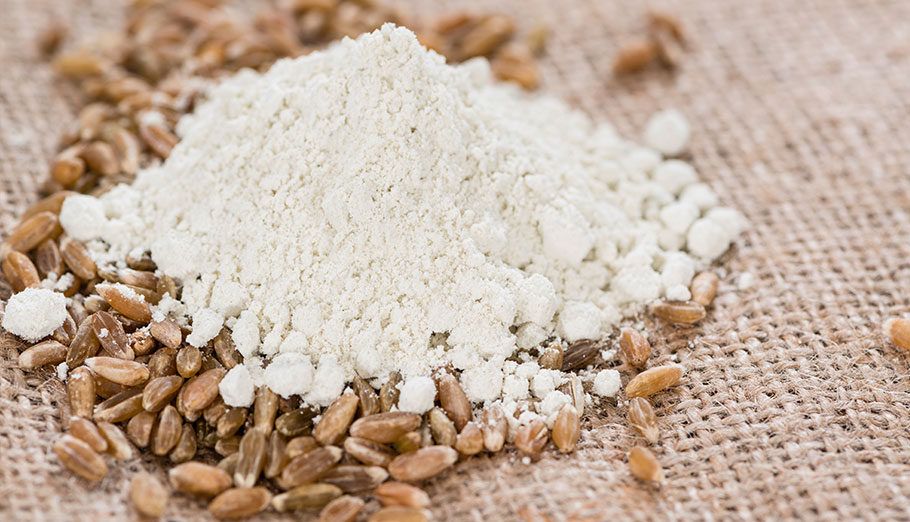Spelt

Overview (Has Gluten)
Spelt (Triticum aestivum var. spelta) is a cereal grain of the wheat family. It looks much like wheat, but has a harder outer shell. Spelt grain has been cultivated since around 5000 BC, originally in Iran, though it only found its way to the United States in the 1890s. It is a primitive non-hybridized wheat popular among organic farmers because it requires fewer fertilizers than conventional wheat.
Spelt flour is one of the most widely used non-wheat flours. Spelt flour has a taste very similar to wheat flour—slightly sweet and nutty—but is more water soluble and easier to digest. Spelt is one of three grains with sufficient gluten to raise bread (wheat and Kamut are the other two). It’s also great for spelt pasta and baking cakes, muffins, cookies, and pie crusts.
Nutrition
Compared to wheat flour, spelt flour is higher in protein and has fewer calories. It is higher in protein and lower in gluten than typical wheat flour, which makes it a good choice for those with sensitivity to gluten. Because it does have gluten, however, it is not suitable for anyone with Celiac disease. Spelt is also more easily digested than wheat flour. It is an excellent source of vitamin B2, niacin, manganese, phosphorus, copper, protein and fiber. The tough outer husk of spelt not only protects it from pests during cultivation but also minimizes the need for pesticides.
Note: Weight of a cup (or partial cup) of flour varies depending upon whether it is lightly sprinkled into a measuring cup or compacted. Most recipe measurements are based on sifted flour as a way to arrive at more uniform measurement.
Gluten Content & Allergen Information
Those who are sensitive to the proteins in wheat usually have no reaction to foods prepared with spelt flour. However, because spelt contains gluten it is not suitable for anyone with Celiac disease or wheat allergies.
Substitutes and Alternatives to Spelt Flour
If you’re going gluten-free, several of the alternative flours are worth considering: amaranth, brown rice, quinoa, and buckwheat all make excellent gluten-free flours.
Nutrition Facts
| Serving Size | 1 Cup |
| Calories | 588 |
| Total Fat 4g | 5% |
| Cholesterol 0mg | 0% |
| Sodium 14mg | 1% |
| Carbohydrates 122g | 41% |
| Dietary Fiber 19g | 64% |
| Total Sugars 12g |
| Protein 25g |
| Vitamin D 0mcg | 0% |
| Calcium 47mg | 4% |
| Iron 8mg | 45% |
| Potassium 0mg | 0% |
* The % Daily Value (DV) tells you how much a nutrient in a serving of food contributes to a daily diet. 2,000 calories a day is used for general nutrition advice.
Diet Compatibility
Paleo Diet
The Paleo Diet seeks to emulate the hunter-gatherer diet of our stone-age ancestors. The emphasis is on wild plants and meats similar to what ancient man would have consumed. As such, dairy products, refined sugar and processed oils are off limits. While many Paleo Diet followers also avoid grains, there is ample archaeological evidence to show that grains were part of Paleolithic era man’s diet.
Compatibility with Spelt Flour:
Not Compatible

Mediterranean Diet
This diet seeks to emulate the diets of those living along the Mediterranean coast, with an emphasis on fresh fruits and vegetables, seafood/fish at least twice a week, limited servings of poultry, and only occasional sweets and red meat.
Compatibility with Spelt Flour:
Compatible

Gluten-Free Diet
As the name suggests, the gluten-free diet eliminates all foods with gluten. Although most of those on a gluten-free diet are on it out of necessity—either due to severe wheat allergies or Celiac disease—many have embraced a gluten-free diet as being healthier.
Compatibility with Spelt Flour:
Compatible

Macrobiotic Diet
Although there are many versions of macrobiotic diets, the common thread is that they emphasize natural, whole foods, grown locally and organically. Whole grains, vegetables, legumes, fruits, seeds and nuts, and occasional seafood are all integral to the diet. Red meats, dairy, poultry, eggs and processed foods are off the menu.
Compatibility with Spelt Flour:
Compatible

Acid Alkaline Diet
This diet aims to restore the slightly alkaline state of the body, which is believed to be ideal. By focusing on a diet high in vegetables, fruits, sprouted grains, lentils, almonds and soy products, the goal is to have a balance of 80% alkalizing foods and 20% acid forming foods.
Compatibility with Spelt Flour:
Compatible – Spelt Flour is considered to be slightly acidic

Low-Carb Diet
As the name suggests, this diet focuses on reducing carbohydrates in the diet to lose weight. The theory is that by staying away from high-carb foods like pasta and bread and eating low carb, high fiber vegetables and fruits instead, your body will go into ketosis and you will lose weight. This diet is sometimes referred to as a ketogenic diet.
Compatibility with Spelt Flour:
Compatible in Limited Quantities

Atkins Diet
The Atkins Diet is a historically popular low carb diet, instructing dieters not to worry about their calories but to monitor and minimize their intake of sugar and carbohydrates. According to Dr. Atkins, depriving the body of its primary energy sources causes the body to burn fat.
Compatibility with Spelt Flour:
Compatible in Limited Quantities

“We love the mill! We use it every day for things from bread, to pastry and it is phenomenal. The biggest selling point for me was the fineness since that would mean we can really do some great pastry with it in addition to bread. It definitely has been great!"
BEN FROM NORTH CAROLINA

